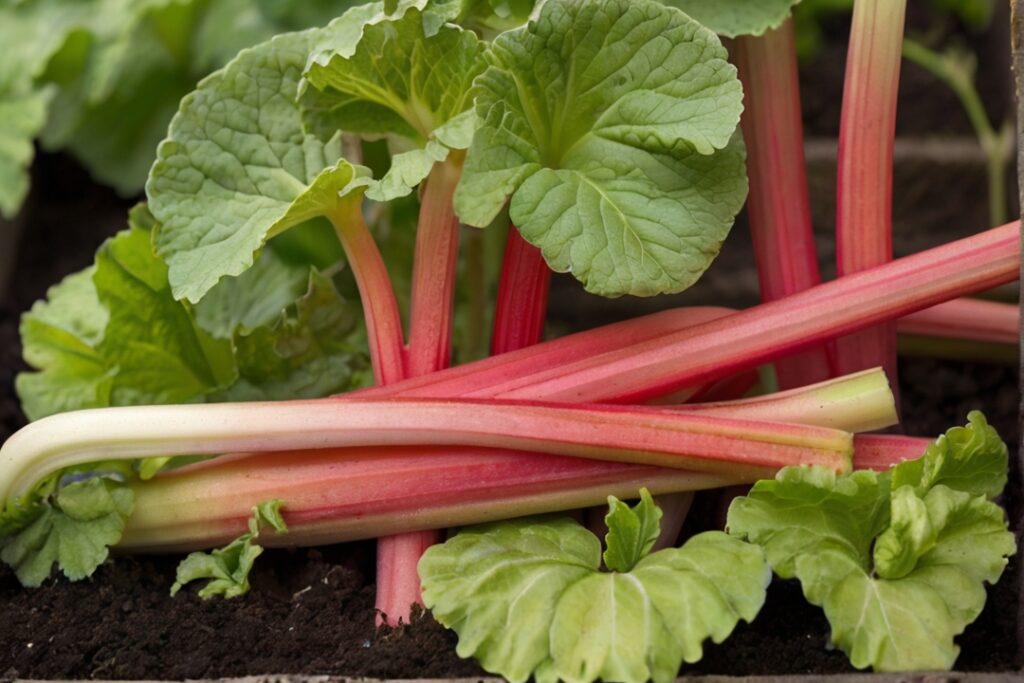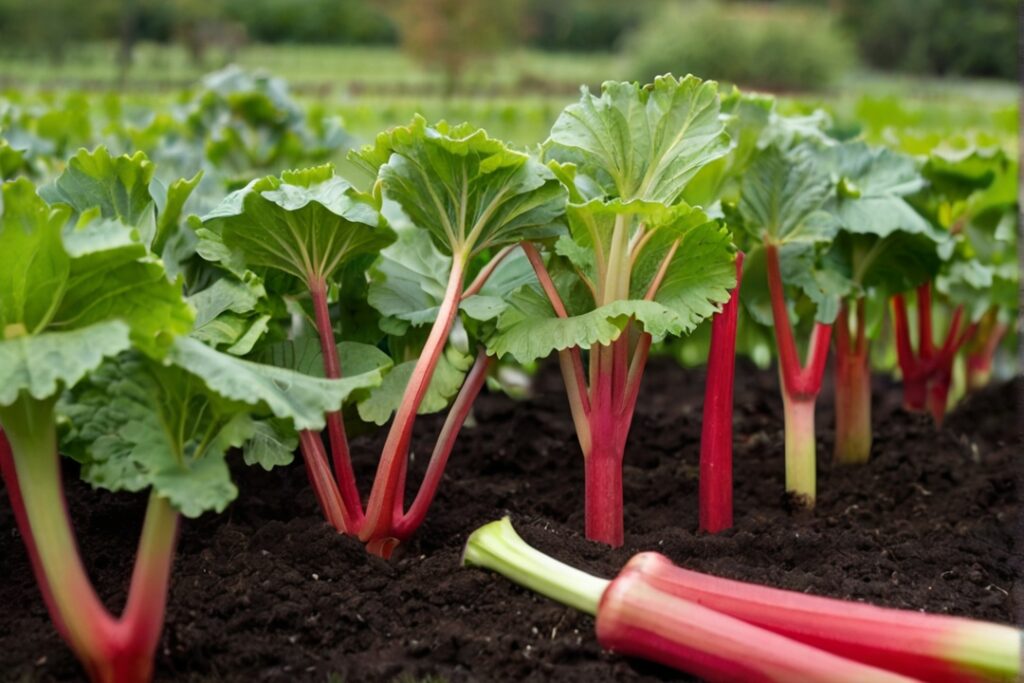Companion planting is a gardening technique that involves planting different plants together to benefit each other. By strategically placing certain plants next to each other, gardeners can create a harmonious and mutually beneficial environment for their crops. Rhubarb is a perennial vegetable that is known for its tart and tangy stalks, which are commonly used in pies, jams, and other culinary creations. In addition to its delicious flavor, rhubarb also offers a range of benefits when used as a companion plant.
- Benefits of Rhubarb Companion Planting
- Best Vegetable Companion Plants for Rhubarb
- Companion Planting with Herbs for Rhubarb
- Companion Planting with Flowers for Rhubarb
- How to Plant Rhubarb with Companion Plants
- Tips for Maintaining Rhubarb Companion Planting
- Common Mistakes to Avoid in Rhubarb Companion Planting
- Enhancing Your Garden with Rhubarb Companion Planting
- FAQs
Benefits of Rhubarb Companion Planting

One of the main benefits of rhubarb companion planting is improved soil health. Rhubarb has deep roots that help to break up compacted soil and improve drainage. This can be especially beneficial for plants that have shallow roots, as it allows them to access nutrients and water more easily. Additionally, rhubarb leaves contain high levels of calcium, which can help to balance the pH of the soil and make it more fertile.
Another benefit of rhubarb companion planting is increased yield and growth of rhubarb itself. When planted alongside certain companion plants, rhubarb can experience enhanced growth and productivity. This is because some plants have the ability to repel pests or attract beneficial insects, which can help to protect the rhubarb plant and promote its overall health.
Best Vegetable Companion Plants for Rhubarb
When it comes to companion planting with rhubarb, there are several vegetables that work particularly well together. Here are some of the best companion plants for rhubarb:
Beans
Beans are nitrogen-fixing plants, which means they have the ability to convert atmospheric nitrogen into a form that can be used by other plants. This can help to improve the overall fertility of the soil and promote healthy growth in rhubarb.
Carrots
Carrots and rhubarb make great companions because they have different root depths. While rhubarb has deep roots, carrots have shallow roots. This allows them to coexist without competing for nutrients and water.
Garlic and onions
Garlic and onions are known for their ability to repel pests, such as aphids and slugs. By planting them alongside rhubarb, you can help to protect the plant from these common garden pests.
Peppers
Peppers, such as bell peppers and chili peppers, can help to deter pests, such as aphids and spider mites. They also have a similar growth habit to rhubarb, which makes them compatible companions.
Tomatoes
Tomatoes and rhubarb are both heavy feeders, meaning they require a lot of nutrients to grow and thrive. By planting them together, you can ensure that they have access to the nutrients they need for healthy growth.
Broccoli, Cauliflower and Cabbage
Broccoli and other brassicas, such as cabbage and cauliflower, are good companions for rhubarb. They can help to repel pests, such as cabbage worms and aphids, which can damage the rhubarb plant.
Cucumber
Cucumber is a good companion for rhubarb because it can help to repel pests, such as aphids and cucumber beetles. It also has a spreading growth habit, which can help to suppress weeds and keep the soil moist.
Lettuce, Spinach and Kale
Lettuce and other leafy greens, such as spinach and kale, are good companions for rhubarb. They have shallow roots, which makes them compatible with the deep-rooted rhubarb plant.
Squash, Zucchini and Pumpkin
Squash and other cucurbits, such as zucchini and pumpkin, are good companions for rhubarb. They have a spreading growth habit, which can help to suppress weeds and keep the soil moist.
Companion Planting with Herbs for Rhubarb

In addition to vegetables, herbs can also be great companion plants for rhubarb. Here are some herbs that work well when planted alongside rhubarb:
Basil
Basil is a great companion for rhubarb because it can help to repel pests, such as aphids and mosquitoes. It also has a strong aroma that can mask the scent of the rhubarb plant, making it less attractive to pests.
Chives
Chives are known for their ability to repel pests, such as aphids and Japanese beetles. They also have shallow roots, which makes them compatible with the deep-rooted rhubarb plant.
Dill
Dill is a beneficial companion for rhubarb because it attracts beneficial insects, such as ladybugs and lacewings, which can help to control pests in the garden.
Mint
Mint is a great companion for rhubarb because it can help to repel pests, such as aphids and ants. It also has a spreading growth habit, which can help to suppress weeds and keep the soil moist.
Rosemary
Rosemary is a good companion for rhubarb because it can help to repel pests, such as cabbage worms and carrot flies. It also has a strong aroma that can mask the scent of the rhubarb plant, making it less attractive to pests.
Sage
Sage is known for its ability to repel pests, such as cabbage worms and carrot flies. It also has a strong aroma that can mask the scent of the rhubarb plant, making it less attractive to pests.
Thyme
Thyme is a beneficial companion for rhubarb because it attracts beneficial insects, such as bees and butterflies, which can help to pollinate the rhubarb flowers.
Companion Planting with Flowers for Rhubarb
In addition to vegetables and herbs, flowers can also be great companion plants for rhubarb. Here are some flowers that work well when planted alongside rhubarb:
Calendula
Calendula is a beneficial companion for rhubarb because it attracts beneficial insects, such as bees and butterflies, which can help to pollinate the rhubarb flowers.
Marigold
Marigold is a great companion for rhubarb because it can help to repel pests, such as aphids and nematodes. It also has a strong aroma that can mask the scent of the rhubarb plant, making it less attractive to pests.
Nasturtium
Nasturtium is a beneficial companion for rhubarb because it attracts beneficial insects, such as ladybugs and lacewings, which can help to control pests in the garden.
Sunflower
Sunflower is a good companion for rhubarb because it can help to attract beneficial insects, such as bees and butterflies, which can help to pollinate the rhubarb flowers.
How to Plant Rhubarb with Companion Plants
When planting rhubarb with companion plants, there are a few key steps to follow to ensure success. Here is a step-by-step guide on how to plant rhubarb with companion plants:
1. Choosing the right location: Rhubarb prefers a sunny location with well-draining soil. Choose a spot in your garden that receives at least six hours of direct sunlight each day and has soil that is rich in organic matter.
2. Preparing the soil: Before planting, prepare the soil by removing any weeds or grass and loosening it with a garden fork or tiller. Add compost or well-rotted manure to improve the fertility and structure of the soil.
3. Planting rhubarb and companion plants: Dig a hole that is wide and deep enough to accommodate the root ball of the rhubarb plant. Place the plant in the hole, making sure that the crown is level with or slightly above the soil surface. Backfill the hole with soil, firming it gently around the plant. Space companion plants according to their specific requirements, taking into consideration their mature size and growth habit.
4. Proper spacing: When planting rhubarb with companion plants, it is important to leave enough space between each plant to allow for proper air circulation and prevent overcrowding. Follow the spacing recommendations for each specific plant to ensure optimal growth and productivity.
Tips for Maintaining Rhubarb Companion Planting
Once you have planted your rhubarb with companion plants, it is important to provide proper care and maintenance to ensure their success. Here are some tips for maintaining rhubarb companion planting:
1. Regular watering: Rhubarb and its companion plants require regular watering to stay healthy and productive. Water deeply and consistently, making sure that the soil is evenly moist but not waterlogged. Avoid overhead watering, as this can promote the spread of diseases.
2. Mulching: Mulching around the base of the plants can help to conserve moisture, suppress weeds, and regulate soil temperature. Use organic mulch, such as straw or wood chips, and apply a layer that is two to three inches thick.
3. Fertilizing: Rhubarb and its companion plants benefit from regular fertilization to ensure optimal growth and productivity. Apply a balanced organic fertilizer, such as compost or well-rotted manure, in early spring and again in midsummer.
4. Pruning: Rhubarb does not require much pruning, but it can benefit from the removal of any dead or damaged leaves or stalks. This can help to improve air circulation and prevent the spread of diseases.
Common Mistakes to Avoid in Rhubarb Companion Planting
While rhubarb companion planting can offer many benefits, there are also some common mistakes that gardeners should avoid. Here are a few mistakes to watch out for:
1. Planting incompatible plants: Not all plants make good companions for rhubarb. Some plants may compete for resources or release chemicals that can inhibit the growth of rhubarb. Be sure to research the compatibility of each plant before planting them together.
2. Overcrowding: It can be tempting to plant as many companion plants as possible around your rhubarb, but overcrowding can actually hinder their growth and productivity. Leave enough space between each plant to allow for proper air circulation and prevent competition for resources.
3. Neglecting maintenance: Rhubarb and its companion plants require regular care and maintenance to stay healthy and productive. Neglecting tasks such as watering, mulching, fertilizing, and pruning can lead to poor growth and increased susceptibility to pests and diseases.
Enhancing Your Garden with Rhubarb Companion Planting
In conclusion, rhubarb companion planting offers a range of benefits for both the rhubarb plant and its companion plants. By strategically planting certain vegetables, herbs, and flowers alongside rhubarb, gardeners can improve soil health, increase yield and growth, provide natural pest control, and attract beneficial insects. When planting rhubarb with companion plants, it is important to choose the right location, prepare the soil properly, plant with proper spacing, and provide regular care and maintenance. By following these tips and avoiding common mistakes, you can enhance your garden and enjoy the many benefits of rhubarb companion planting. So why not give it a try in your own garden?
FAQs
What is companion planting?
Companion planting is the practice of planting different crops together in a way that benefits one or both plants.
What are the benefits of companion planting with rhubarb?
Companion planting with rhubarb can help deter pests, improve soil health, and increase yields of both the rhubarb and its companion plants.
How should I plant my rhubarb and its companion plants?
Plant rhubarb and its companion plants in a sunny location with well-draining soil. Space the plants according to their individual needs and water regularly.
Can I plant rhubarb and its companion plants in containers?
Yes, rhubarb and its companion plants can be grown in containers as long as the container is large enough to accommodate the plants and has good drainage.

